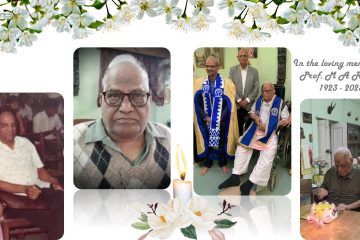 Why is a black coat and dark trousers the invariable wear during placements? If Pradeep Poddar, who just landed a placement with Accenture, is to be believed, it is only because students are following tradition. “We have seen pictures of our seniors wearing black, and so black it is,” says Pradeep, who is a final year Dual Degree student of Metallurgical and Materials Engineering.
Why is a black coat and dark trousers the invariable wear during placements? If Pradeep Poddar, who just landed a placement with Accenture, is to be believed, it is only because students are following tradition. “We have seen pictures of our seniors wearing black, and so black it is,” says Pradeep, who is a final year Dual Degree student of Metallurgical and Materials Engineering.
But except for the colour, everything else seems to have changed about placements.
For one, placements were not concentrated around the month of December and January. Alumnus and Associate Professor of Mechanical Engineering, Prof. Anandaroop Bhattacharya (1997/BTech/ME), says, “Placements during my time used to take place throughout the semester. Moreover, if one had got a job offer, one had to wait till all others in the Department had gone through the process and got offers, to wait for a second offer.”Besides, adds Prof. Bhattacharya, whatever happened, happened on the day of the interview.
 Not so anymore. The placement process is much more intensive. Pradeep, for example, braced 40-45 tests from companies from the month of October before going for the placement process in early December. “According to the set rules, no tests could happen from 8 am to 5 pm, but starting from evening, some of us took tests way into the night,” says Pradeep.
Not so anymore. The placement process is much more intensive. Pradeep, for example, braced 40-45 tests from companies from the month of October before going for the placement process in early December. “According to the set rules, no tests could happen from 8 am to 5 pm, but starting from evening, some of us took tests way into the night,” says Pradeep.
He also prepared himself rigorously in coding, analytics, computer programming and on other platforms together with his friends. Some of this information was provided by the CDC itself, which keeps a repository of the feedback from previous years’ students facing the placement process. “On some of these platforms, you can enrol yourself to learn how to crack puzzles, gain expertise in data structure and programming for free,” says Pradeep.
Perhaps the process may be said to have started even earlier, with the compulsory internship in the third year for which students earn two credits. Himanshu Mundhra, a third year student of Computer Science and Engineering and a blog writer on Medium talks of how he had begun preparation for his internship interview from the second year itself https://medium.com/@himanshumundhra98/internship-chronicles-the-cdc-chapter-948d1a1f5a51
If Himanshu’s experience is anything to go by, a CDC internship does not come easy either. In fact, the IIT KgpFundae– anonymously Facebook account is strewn with worries being voiced on what happens when one is unable to secure such an internship. Many, like Pradeep, work their LinkedIn network to land off campus corporate internships.
 But apart from the duration and the intensity of the placement process, there are other differences. Take job offers from the core sector. Prof. Bhattacharya says, “The number of companies and job offers in the core sector may have remained the same or even increased, but the number of students have gone up 3-4 times. So if you take the ratio of core jobs to number of applicants, it has definitely reduced. A lot of students now go for sectors different from their own discipline, perhaps aware that there are not many jobs to go around which are related to their discipline.”
But apart from the duration and the intensity of the placement process, there are other differences. Take job offers from the core sector. Prof. Bhattacharya says, “The number of companies and job offers in the core sector may have remained the same or even increased, but the number of students have gone up 3-4 times. So if you take the ratio of core jobs to number of applicants, it has definitely reduced. A lot of students now go for sectors different from their own discipline, perhaps aware that there are not many jobs to go around which are related to their discipline.”
The picture gets even rosier if one looks ahead at the early Nineties. Prof. Pallab Dasgupta, Professor, Computer Science and Engineering, who completed his B.Tech in 1990 and M. Tech in 1992 from the same department, says, “Since there were only a few IITs and a limited number of graduates – there were only 21 in my batch from my Department – the number of jobs were comfortably more than the number of students. So getting a job was fairly easy. Many, in fact, had multiple offers from companies as many left for foreign shores for research.” Prof. Dasgupta even calls it a “problem of plenty”.
The situation seems to have taken a 360 degree turn. An IIT Kharagpur: Undergraduate Mental Health Survey (https://medium.com/@shastrarth.iitkgp/iit-kharagpur-undergraduate-mental-health-survey-196082ef67db) puts “CDC internships, and then the placements hunt as the most stressful phase of their academic life in KGP”, with many putting the period after the third year as a completely different phase of their student life.
 But nothing apparently can prepare a student for what ultimately happens during placements. Pradeep, for one, calls the process of selection “quite random”. His friend, Rajesh Yadav, a Dual Degree student of Metallurgical and Materials Engineering Department, says that he had concentrated on garnering software skills throughout college. He, in fact, appears mildly surprised by being chosen by Société Générale, a French multinational investment bank and financial services company, despite not having any experience in finance.
But nothing apparently can prepare a student for what ultimately happens during placements. Pradeep, for one, calls the process of selection “quite random”. His friend, Rajesh Yadav, a Dual Degree student of Metallurgical and Materials Engineering Department, says that he had concentrated on garnering software skills throughout college. He, in fact, appears mildly surprised by being chosen by Société Générale, a French multinational investment bank and financial services company, despite not having any experience in finance.
Pradeep explains, “As an interviewee, it is your job to convince the interviewers that you are the right candidate.” There are, obviously, no magic formulae for this. Pradeep supposes that the test he gave for Accenture in October had gone right, and hence the placement offer was perhaps natural. But he is not sure if that is the only explanation.
Most going for placements take this uncertainty factor on their chin and brace hard for it. Prof. Bhattacharya is, in fact, visibly impressed by the sureheadedness of the students of today. “Students are very sorted out in their minds whether they would opt for placements or not. Some of my students skip placements altogether as they know that they are going into research. Yes, I would say that they are way more sure now about where they are headed than they were during my time,” says Prof. Bhattacharya.
The other thing that impresses him is their professional way that students dress for the placement. “For us, it was different. We often used to borrow each other ties and shirts. More than shirts, we used to share shoes. There were probably 2 formal shoes in my wing where 6 of us were applying for jobs – one was size 8, the other 10. Even if the size did not fit, we would say, ‘How does it matter? You will be sitting during the interview anyway’. That was our definition of one (well two) size fits all,” Prof. Bhattacharya adds with a laugh.
Pradeep laughs as well on hearing about this, perhaps at the impossibility of that happening today. For his placements, he chose a blue jacket, but only because he had the material lying around in his home. Left to his own, he would have settled for black.
Photographs: Suman Sutradhar



